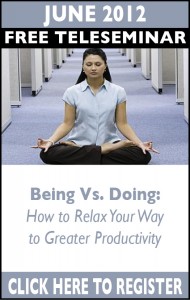Category Archives for Work Life Balance Tips
From Complaining to Inspiration
 “If you have time to whine and complain about something then you have the time to do something about it.” ~Anthony J. D’Angelo, The College Blue Book
“If you have time to whine and complain about something then you have the time to do something about it.” ~Anthony J. D’Angelo, The College Blue Book
It’s always amazing to me where I find inspiration. From driving around, to a story in the news, to the own inner workings of my mind, ideas come from anywhere and everywhere. Yet, having the time to do anything with that inspiration is another story. Or, shall I say making the time to do something with that inspiration…
After succumbing to some of the stresses of my life over the last few weeks, I realized I haven’t been doing as much with my inspiration lately as I would like. I found myself griping about all the “shoulds” and “have to’s” on my to-do list, and lamenting the days when I had time to let an idea just unfold, whether it was working on an article, book, song, etc. A while ago, when I was having a long pity party, my son looked at me and simply said “if it’s that important to you, you should spend at least two hours a week doing it.” Out of the mouths of babes. Why didn’t I think of that? Truth is, I had, but rather than just acting on it, I was spending time stuck in all the things keeping me from what I wanted to do. Does that ever happen to you?
Do you ever notice that it seems to take much more energy complaining than it does doing something to change the situation? I know it does for me. Yet it is easy to fall into the illusion that complaining is helping. That is not to say that venting about a difficult situation isn’t helpful. It sure can be to alleviate some of the pent up feelings. But when venting becomes frequent and is just a rehashing of the same things, it can become destructive and unhealthy.
The trick is to get yourself out of that stuck place and into the space where inspiration lives again. Although it can seem like a monumental task (which is another illusion), it may simply be a matter of changing your mind.
Here’s some things to try that may help you jump start your inspiration and get out of that stuck place:
- Use seemingly wasted time, like waiting in the doctor’s office, to do something you want to do, like read a book, listen to music, meditate, or write a letter. Be prepared by always carrying a bag of things you want to do.
- Identify someone who is supportive of you and meet them for coffee or lunch to discuss what you want to do (not what you don’t).
- Change your scenery. Go to the park, the zoo, or somewhere you don’t go to very often (especially in nature). Sometimes a simple change of surroundings can shift your energy and mood and get you back in touch with what is important to you.
- Tell your stress to take a vacation. Declare a specific amount of time, 5 minutes to start, as “no-stress” time. Dare to dream, hope, visualize, etc. the life you want for yourself.
- Remember this is your life. Not your employer’s life, not the economy’s life, not your parents’ or partner’s life. If you don’t own it, someone or something else will.
Instead of spending your precious time and energy focused on what you don’t want, make an effort to focus on what you want. I bet you’ll notice a difference. And I’d love to hear about it. Leave a comment below.
Photo: Light Bulb © by olga.belobaba
Being Vs. Doing: Are You Ready to Relax Your Way to Greater Productivity?
 Do you find yourself spinning your wheels, pushing yourself harder and harder, trying to get more done, and thinking “if I could just finish my to-do list, everything would be better?”
Do you find yourself spinning your wheels, pushing yourself harder and harder, trying to get more done, and thinking “if I could just finish my to-do list, everything would be better?”
Our society values accomplishments. Set a goal, work hard, achieve your goal. Rinse and repeat. But is life only about achievement? And if we’re always focused on doing doing doing, what can happen to our being or our spirit? BURN OUT, that’s what.
If you’re ready to start practicing the art of being rather than doing and get away from the constant burn-out cycle, please join me for June’s FREE Teleseminar…“Being Vs. Doing: Relax Your Way to Greater Productivity.”
In this teleseminar, I’ll cover:
- The Price of Living Life as a Human Doing Rather than a Human Being
- The Triangle of Doingness that Keeps You Stuck (and How to Overcome it)
- 3 Steps You Can Take to Relax Your Way to Greater Productivity
Don’t delay. Sign up today. The live call is coming soon. But don’t worry, if you can’t attend live, you can still sign up and get access to the recording. Simply go to the REGISTRATION page and enter your name and email to get signed up.
Ditching the Disease to Please: Goodbye “Good Girl,” Hello HAPPY ☺ Girl
If women are “programmed” to do anything, it’s to please others and be a “good girl.” And by “good” it is assumed you will:
- Be compliant and not complain about what is expected of you, which is more than any one person could possibly do anyway.
- Do for others RATHER than do for yourself.
- Sacrifice, sacrifice, sacrifice.
- Forget about your hopes, dreams, passions, and goals.
And if you do any or all of those things listed above, it’s a recipe for disaster. Whenever you put yourself at the bottom of your priority list, it takes a toll on you – your physical, emotional, and mental health. It sends a message, not only to you, but to everyone around you that you’re not important, that you don’t matter.
 Dr. Wayne Dyer has said “You get treated in life the way you teach people to treat you.” What are you teaching people? To treat you like a deserving, lovable, competent, intelligent, independent, worthy woman. OR, to treat you like someone who will always be there to do what other people can’t, won’t, or don’t want to do?
Dr. Wayne Dyer has said “You get treated in life the way you teach people to treat you.” What are you teaching people? To treat you like a deserving, lovable, competent, intelligent, independent, worthy woman. OR, to treat you like someone who will always be there to do what other people can’t, won’t, or don’t want to do?
To find out if you tend to be a people pleaser, answer the following true or false questions:
- I say yes to other people’s requests even when I really want to say no.
- I get anxious at the thought of someone not liking me or something I’ve done (or not done).
- I feel resentful when I do things for other people.
- I feel resentful when other people don’t do things for me, especially when I do so much for them.
- I want people to automatically know what I want or need without having to say it.
If you’ve answered yes to any of these questions, you just might be a people pleaser. The good news is you can unlearn your people-pleasing ways and get back to putting yourself at the top of your priority list. In order to be treated the way you deserve to be treated, you must first start with yourself. People take clues on how to treat you by watching how you treat yourself. So treat yourself well. Here’s some tips on how:
- Define your priorities. Make a list of all your priorites in life, such as your family, friends, job, finances, health, etc. Then pick the top three you’d like to focus on in the next month or so. Write out your list and keep it where you can see it or refer to it. When asked to do something, check in with your priority list. If the request isn’t aligned with your priorities, it will be easier to turn it down.
- Schedule yourself on your calendar. We fill up our schedules with meetings, appointments, errands, etc. If it’s on your calendar, you know it needs to get done. So why not use that to your advantage and block out some time for yourself.
- Learn to say no. The word “no” is one that none of us like to hear. So it might be easier to think of saying no to others in terms of saying YES to yourself. If someone asks you to do something you really don’t want to do, keep your priority of saying yes to yourself in mind and politely decline the request. This is a skill that takes some practice. You might want to start by saying no to small things first and with people you know won’t be easily upset. Once you have small successes under your belt, it will be easier to say no to bigger things and with people who are more vested in getting their way than in you being happy.
For more ideas on how to ditch that annoying disease to please, please join me for my next monthly FREE Telseminar, “Getting Over the Good Girl Syndrome: Learning to Say No.” Simply go to the REGISTRATION page at https://krylyn.com/free-teleseminars/getting-over-the-good-girl-syndrome, and enter your name and email to get signed up. Even if you can’t attend the live call, you will get access to the recording of the call, but only if you register.
A Word About Life’s Challenges: The Onion Always Has More Layers
 “Whatever you have forgotten, you can remember. Whatever you have buried you can unearth. If you are willing to look deep into your own nature, if you are willing to peel away the layers of not-self you have adopted in making your way through the tribulations of life, you will find that your true self is not as far removed as you think.” -Meredith Jordan
“Whatever you have forgotten, you can remember. Whatever you have buried you can unearth. If you are willing to look deep into your own nature, if you are willing to peel away the layers of not-self you have adopted in making your way through the tribulations of life, you will find that your true self is not as far removed as you think.” -Meredith Jordan
Just when I think I’ve transcended a challenge, another one pops up that is similar or somehow related to the initial challenge. Does this ever happen to you?
There’s an analogy you may be familiar with about peeling back the layers of an onion. Basically, it means that a challenge or problem we’re faced with has many facets and the deeper we go to deal with it, the more we find out…about the challenge, other people involved in it, and ultimately ourselves.
Even when we think the challenge is over, it may come back again days, weeks, or years later disguised as something new, but really, it relates to something old. This happens to me and I’m getting better at recognizing how new challenges are just old ones in disguise.
I believe there’s always more layers. More to learn, more to experience, more to transcend. While it may be easy to get frustrated by this, think about it this way…what would life be like if there weren’t anything more to learn? Once you bask in the simplicity of living such a life, really think about it.
It really boils down to willingness…to be open to the lessons and to be gentle with ourselves in the process. I do believe we learn the most about ourselves during times of challenge. So, go find a challenge today, embrace it, and try these tips:
- Identify one challenge. Does it involve a relationship, your job, finances, health, etc.? What feelings do you have about your challenge? What thoughts? Where do you feel it in your body? Have you experienced these same feelings, thoughts, or physical issues with other challenges? How were those challenges similar to the one you are currently facing? Journal your answers and see what comes up.
- Embrace the emotion. While you may feel pain, fear, discomfort, or a slew of other feelings as you go through a challenge, know that that is normal. When we make an effort to avoid our feelings (with distractions such as work, TV, food, etc.) we are really doing a disservice to ourselves. It is important to allow the feelings to come up, experience them, and then let them subside on their own. This helps us move through them and get to the other side.
- Find the lessons. Can you find gratitude in your challenge? What are you learning about yourself, others, life? Take some time to write down the lessons you are learning and the value of the lessons. It might be painful or uncomfortable now, but the more
And as I always say, be gentle with yourself as you go through these tips. You don’t need to add the challenge of being hard on yourself on top of everything else.
I’d love to hear about how you are moving through a challenge in your life. Please leave a comment below.
Photo: Onion Macro © by Dottie Mae
Ready to Clear Away That Which Doesn’t Serve You?
 April is prime time to tackle that dreaded Spring Cleaning. Out with the old, in with the new. Time to dust off that which no longer serves a purpose. The connection between clutter and our mood is astounding. If you don’t believe me, try to have a coherent thought, finish a project, or feel at ease in a room filled with piles of paper, unpaid bills, unanswered requests, stuff not put away, trash, etc. And if that’s not enough, think about all the stuff inside that gets in the way – the negative thoughts, inner critical voice, fear, worry, etc. It’s a wonder we get anything done at all sometimes.
April is prime time to tackle that dreaded Spring Cleaning. Out with the old, in with the new. Time to dust off that which no longer serves a purpose. The connection between clutter and our mood is astounding. If you don’t believe me, try to have a coherent thought, finish a project, or feel at ease in a room filled with piles of paper, unpaid bills, unanswered requests, stuff not put away, trash, etc. And if that’s not enough, think about all the stuff inside that gets in the way – the negative thoughts, inner critical voice, fear, worry, etc. It’s a wonder we get anything done at all sometimes.
When we are distracted by the inner and outer clutter of our lives, we miss a lot. Sure we may be able to function, but are we truly enjoying life, our work, and the people around us? Or are we just holding it together hoping nothing (and no one) will come along to send us over the edge?
If you’re ready to take out what’s holding you back and move forward to a life of more ease and less stuff, please join me for April’s FREE Teleseminar… Clearing the Clutter: How 15 Minutes Could Save Your Sanity.
In this teleseminar, I’ll cover:
- The Different Types of Clutter Affecting Your Mind, Body, and Spirit (it’s not all about the stuff you can see)
- The Connection Between How You Care for Your Stuff and How You Feel About…Everything
- 3 Steps You Can Take to Clear Out What’s Holding You Back So You Can Move Forward
Don’t delay. Sign up today. The live call is coming soon. But don’t worry, if you can’t attend live, you can still sign up and get access to the recording. Simply go to the REGISTRATION page and enter your name and email to get signed up.
How Clutter Affects What You Think and How You Feel

The connection between clutter and our mood is astounding. If you don’t believe me, try to have a coherent thought, finish a project, or feel at ease in a room filled with piles of paper, unpaid bills, unanswered requests, stuff not put away, trash, etc. And if that’s not enough, think about all the stuff inside that gets in the way – the negative thoughts, inner critical voice, fear, worry, etc. It’s a wonder we get anything done at all sometimes.
When we are distracted by the inner and outer clutter of our lives, we miss a lot. Sure we may be able to function, but are we truly enjoying life, our work, and the people around us? Or are we just holding it together hoping nothing (and no one) will come along to send us over the edge?
I want you to really think about how you care for your clutter. Remember in a previous article, 3 Types of Clutter That May Be Holding You Back, I talked about the clutter in your home (physical), heart (emotional), and head (mental). Well, they are all connected, which is both good and bad news. Let me take you through a scenario and see if you can relate…
You come home from a very long, stressful day at work. You walk in the house to find you don’t have enough room to put your purse, briefcase, or whatever else you’re carrying because every surface (table, chair) is packed with stuff. You set the stuff you’re carrying on the floor in a space that hasn’t already been taken over by clutter.
Thoughts start to creep in: I can’t deal with this right now. Why can’t someone else just clean this up. No one cares enough to help me out. Can’t they see how stressed I am. I need a break. I hate working these many hours. I don’t have time for myself. Why can’t I make myself more of a priority.
Emotions start to bubble over: Resentment at your family for not cleaning up. They have enough time to watch TV and play video games while you are slaving away at work all day. Anger at your boss, employer, or clients for taking all your time and energy to the point you don’t have enough left over to deal with simple tasks like cleaning or having time to yourself when you get home.
So you can see, what started off as not having space to put your stuff can spiral into negative thoughts and feelings. And you know it’s not about the stuff. It’s not about the space. It’s not even really about what others in your home are (or aren’t doing). It’s about all that other stuff that it represents. How you feel about yourself and your situation. It’s all inter-connected.
Now for the good news. Knowing that all the clutter is connected, once you start working on one form of clutter, you will notice a shift in the others. Let’s look that scenario again from a different perspective…
You come home from a very long, stressful day at work. You walk in the house to find you don’t have enough room to put your purse, briefcase, or whatever else you’re carrying because every surface (table, chair) is packed with stuff. You set the stuff you’re carrying on the floor in a space that hasn’t already been taken over by clutter.
You take a deep breath and decide to let go of any negative thoughts that start to creep in and instead think things like: I just had a really tough day at work. I need a break, so I’m going to take one right now. I deserve to take some time for me when I come home from a stressful day. Once my break is over, I’ll decide what to do next.
Because you didn’t go to the negative thoughts, your emotions don’t spiral out of control. Instead of feeling resentful and angry, you feel calmer because you took some time for yourself, which is really what you needed. Then from that calmer, more centered place you can decide what you want to do about the physical clutter.
It takes commitment and consistent practice to get from scenario A to scenario B, but it can be done. The trick is remembering to put yourself as a priority and not let yourself slip down the dark hole of negative thoughts and feelings. Another great way to tackle clutter is to start with clearing the physical clutter around you. Remember, a change in one type of clutter affects the others. So if you begin clearing your physical space, you’ll notice you feel better about yourself and life. Give it a try!
For more ideas on tackling clutter and feeling better about yourself, please join me for my next monthly FREE Telseminar, “Clearing the Clutter: How 15 Minutes Could Save Your Sanity.” Simply go to the REGISTRATION page at https://krylyn.com/dev/free-teleseminars/clearing-the-clutter/, and enter your name and email to get signed up. Even if you can’t attend the live call, you will get access to the recording of the call, but only if you register.
